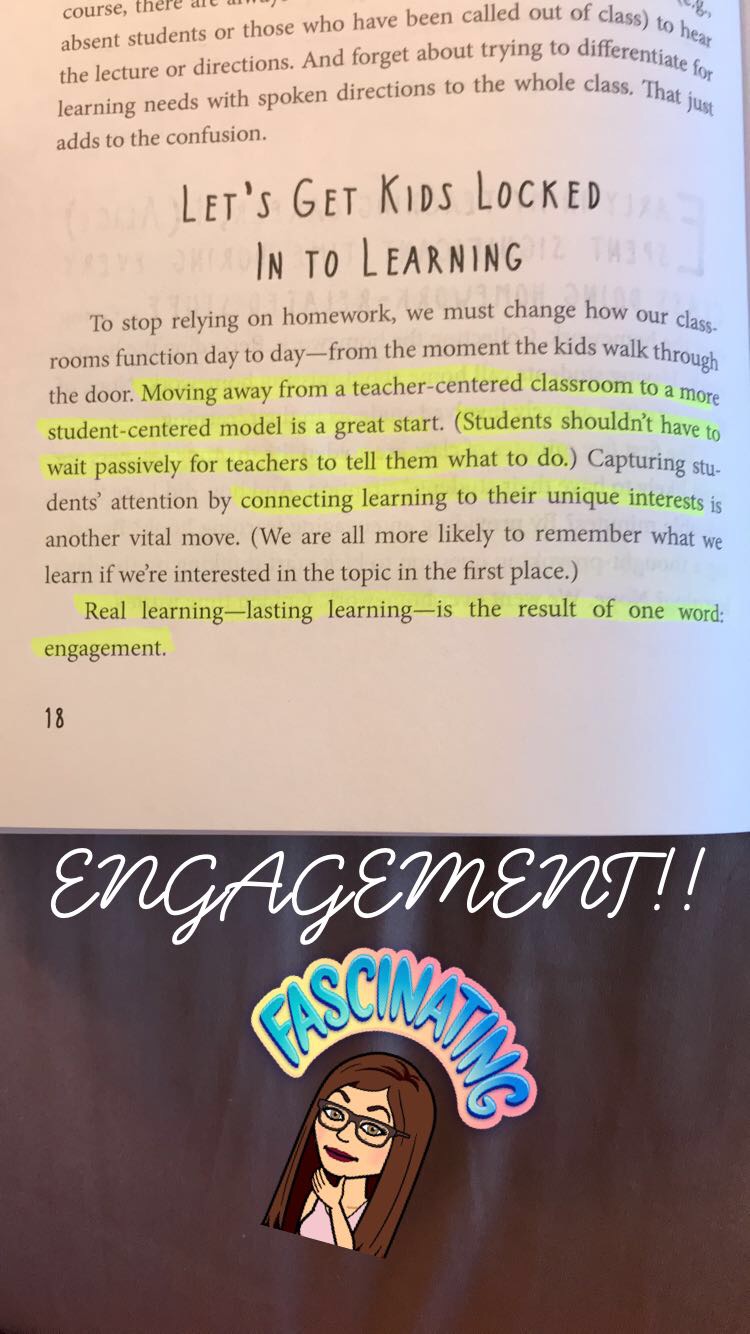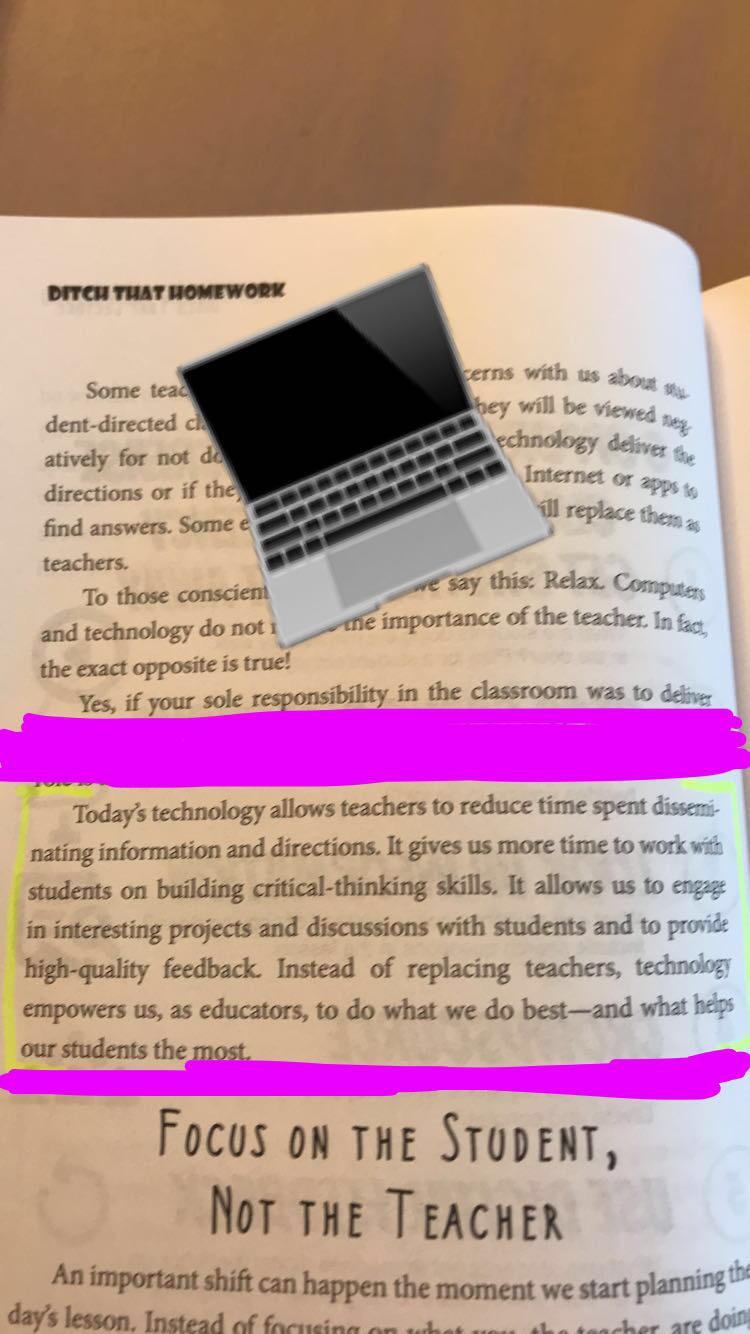While at #ISTE18 we had the opportunity to receive signed copies of “Ditch That Homework” by Matt Miller and Alice Keeler. We both have been wanting to read this book, knowing all the research out there about whether homework was a good or bad thing. This book was a perfect read to get our minds thinking as we start planning for the new school year. Below are the takeaways we each took from the book.
*****
JESS:
First off, before reading this book I have read research about whether homework was good or bad. Teaching elementary school I have always believed in NO HOMEWORK, because when a child isn’t at school they should be playing and being a kid. I do however, have the students read 20 minutes a night (5 out of 7 days of the week) and study for tests or their vocabulary words for the week and work on math fact fluency (especially multiplication in 3rd grade). From this book I enjoyed a lot of what the authors had to say. Of course I created a few booksnaps from my favorite parts of the book.

“It’s the brain of a well-trained educator, who can design educational tasks that stimulate, inspire, and equip students (page 1).” Yaaaaas! Creating and designing educational tasks for my students I know they will love and enjoy is one of my favorite things to do. As an educator, I am all about ditching those old textbooks, too. I know some people LOVE textbooks, yet for Social Studies, for example, I can show the students a picture of the world and then their community on a picture in their textbook or take them on a trip using Google Earth...I am going to choose Google Earth. ENGAGEMENT PEOPLE!

“The first five minutes of class are golden. It’s the time teachers are most likely to have their students’ attention...By providing an engaging learning hook? By asking a thought-provoking question to kick-start thinking on the day’s learning?” (page 17). When I taught middle school I always used a Do Now to start my ELA class. Yet, now that I am in 3rd grade I have struggled with this as I have the same kids all day long. This year I am really going to focus on the first 5 minutes of each subject area and use that transition time to really hook the kids into what we are learning in the next subject. That is one of my personal goals when it comes to lesson planning this school year.

“Moving away from a teacher-centered classroom to a more student-centered model is a great start...Real learning - lasting learning - is the result of one word: engagement” (page 18). Engagement is so important in a classroom. Creating lessons that students are interested in and that capture their attention can be challenging sometimes, yet necessary. When it comes to teaching, ENGAGEMENT, is one of my favorite words!

“Today’s technology allows teachers to reduce time spent disseminating information and directions. It gives us more time to work with students on building critical-thinking skills.It allows us to engage in interesting projects and discussions with students and to provide high-quality feedback. Instead of replacing teachers, technology empowers us, as educators, to do what we do best -- and what helps our students the most” (page 22). Oh boy, this paragraph gave me all the feels. Every educator needs to read this paragraph, reflect on this paragraph, and then re-read it again. I know a lot of educators are scared of technology. Yet, technology speaks to my soul and my students KNOW that when they are with me we are going to be rocking some technology because not only does it empower myself and my lessons, it empowers my students as well.
This book is a great read to give you that “umph” you need right before school. I know some districts and/or schools require homework, yet this book might be something to suggest to help administrators understand why homework isn’t the answer and it’s time to DITCH THAT HOMEWORK!
*****
STEPH:
As a former 8th grade teacher and current high school teacher, I might be in the minority of my peers in my beliefs on homework. Since my first year of teaching, I have never relied heavily on homework. My student population the last 8 years was always a mixed bag, but more often than not too many of my students had a lot more responsibility outside of school than I ever had at that age. For this reason, I only assigned homework occasionally - and I’ll admit it, it was busywork! It may have reinforced the topic we covered in class, but it was often only completed by the students that didn’t necessarily need that extra help.
This book was definitely a must-read for me and I cannot wait to share what I’ve learned with others in my building knowing that many of them still rely heavily on homework. Instead of this book working to convince me that homework may not be the best learning strategy (because I already agreed with that statement), it provided me with more tools for effective instruction and engagement!
To be honest, there are so many takeaways from Ditch that Homework, I could write several posts so I’m going to try my best to narrow my post to a few of my favorite points made by Matt Miller and Alice Keeler.
First - homework can actually cause larger inequalities in your classroom. (page xvii) Grades in your class could eventually (partially) reflect the amount of support and resources students have at home - not necessarily their abilities, skills or knowledge of your class topics. I know this is a very real scenario for my students. In high school, I could be creating disparities between students that have siblings to take care of or none, jobs to help the household, internet or no internet access or stable households or not. These factors should not impact the success of a student in class - many times they are factors out of their control and the homework can cause more stress than academic help.
When planning for the upcoming school year (which started in April) I really started to push myself towards more student-centered and student-driven learning. After a year of just trying to stay afloat with a newborn at home and 2 brand new preps, I am ready to be the teacher I want to be… a facilitator of learning. Thanks to Matt and Alice, I feel empowered to create the classroom I’ve created in my mind and started planning for. I have the privilege of a 1:1 (Chromebooks) classroom and I plan to utilize technology to help students become the decision makers in the classroom. On page 37 (after sharing strategies and tools), Alice cemented my ideas with this tip: Instead of focusing on assignments you want to students to do, provide students with the learning objectives then let them decide how they show you what they know!
I think this fits perfectly with another quote shared in the book on page 92: “Spoon feeding, in the long run, teaches us nothing but the shape of the spoon.” E.M. Forster.
I am preparing to deal with some student resistance to my methods this year, but am encouraged by everything I’ve read in this book… again, way too much to mention here!
Alice and Matt also bring up excellent points about relationships - the foundation of any solid learning environment. Restructuring your class and taking away the added stressor of homework can really help improve the relationships between students and their teacher. Finding methods, perhaps the in-class flip, that gives the teacher the ability to sit one-on-one with a student and provide timely feedback is so much more effective than assigning homework that often doesn’t receive feedback for at least 24 hours (more likely 48 hours).
Last, I will praise Alice and Matt for the amazing resources and graphics shared throughout the book. There are some great Google add-ons that I’m excited to try, especially a handy parent log! I’m also tempted to turn their graphic pages into posters to have in my planning area to keep me constantly reminded of the learning throughout the book!
So, what I’m really trying to say is… if you haven’t read this book, do it! Now! Before the school year starts!
*****
